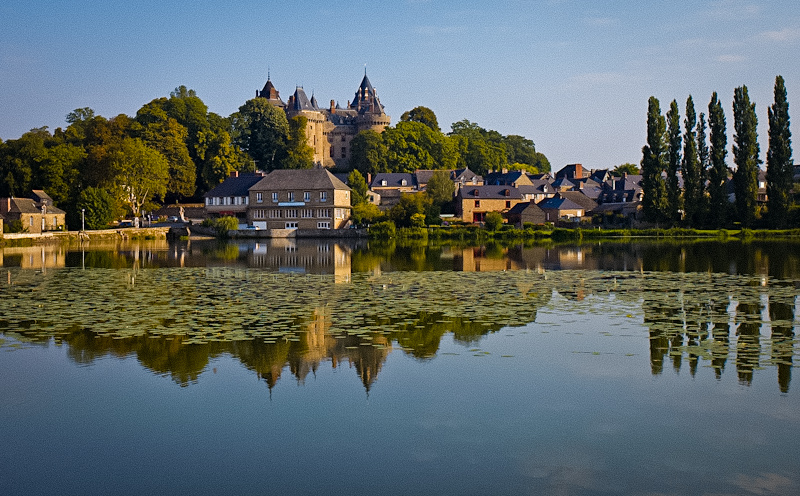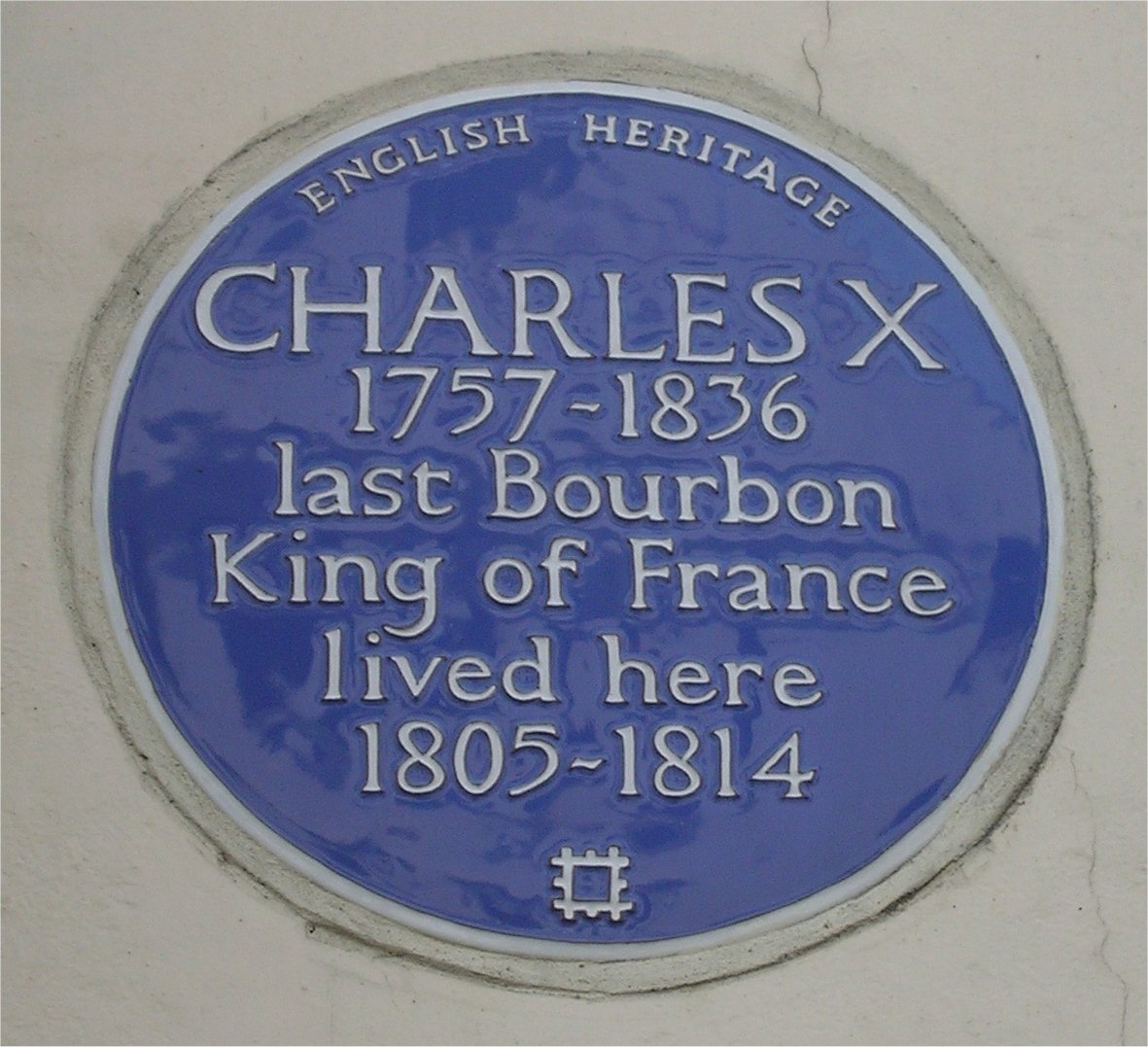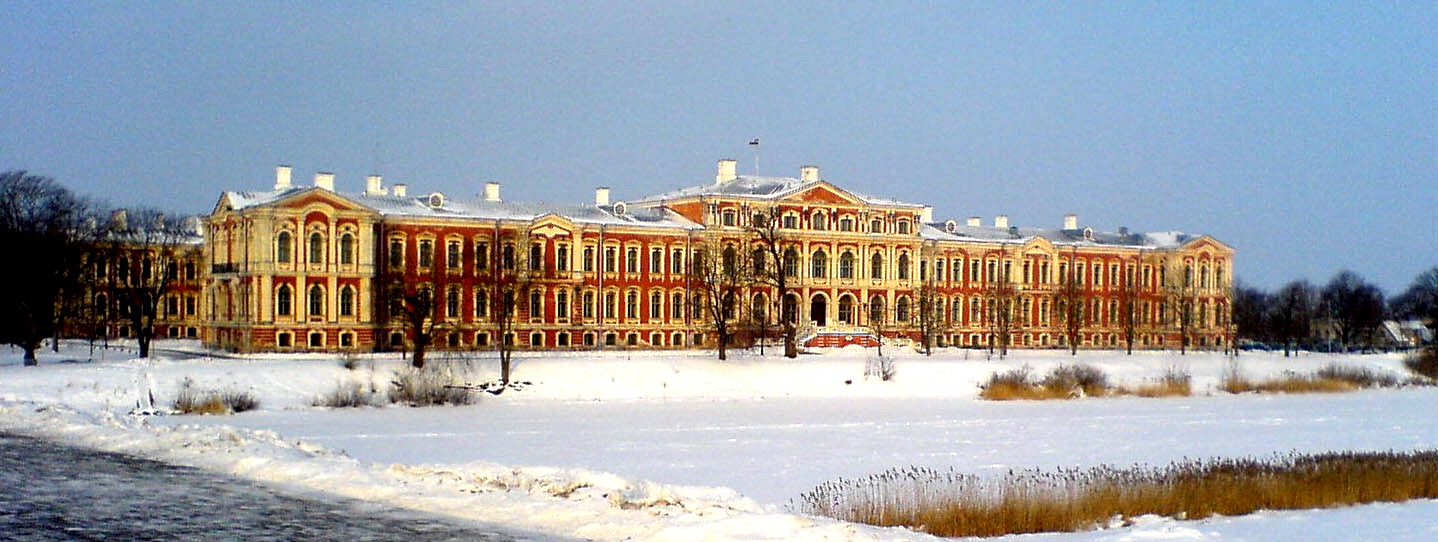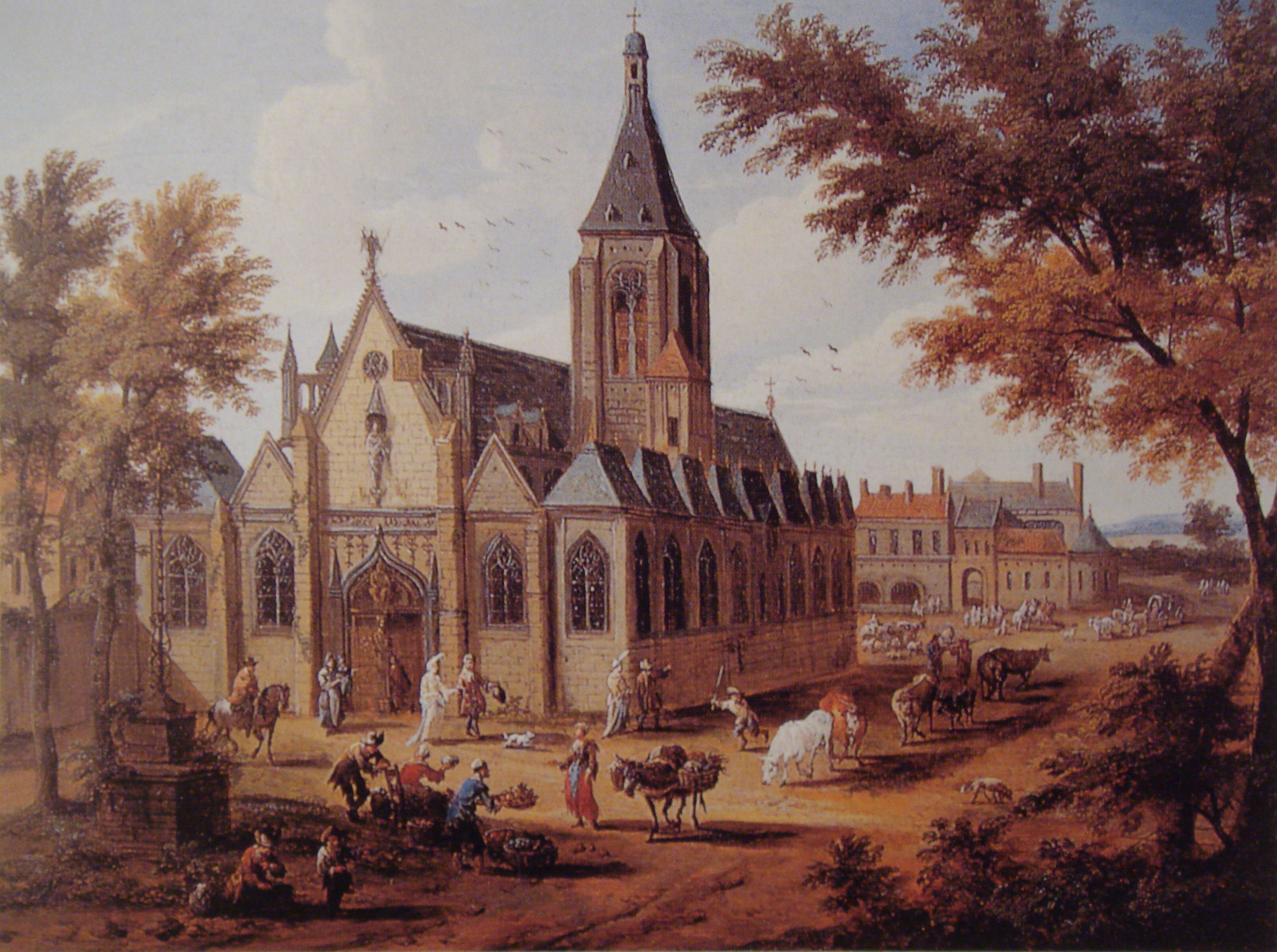|
Hyacinthe-Louis De Quélen
Hyacinthe-Louis De Quélen (8 October 1778 – 31 December 1839) was an Archbishop of Paris. He was the fourth archbishop to serve the Paris diocese after the restoration of the French hierarchy in 1802. Biography De Quélen was born in Paris, in the Quélen noble Breton family. His motto "Em Pob Emser Quelen" and the older Breton expression for "Better death than dishonour" figure in stained glass in the Lazarist church in the rue de Sèvres. He was educated at the College of Navarre and the seminary in St. Sulpice. Ordained in 1807, he served a year as Vicar-General of Saint-Brieuc and then became secretary to Joseph Fesch, uncle to Napoleon Bonaparte. When the latter was exiled from his diocese of Lyon under the Bourbon Restoration, de Quélen exercised his ministry at Saint-Sulpice and in the military hospitals. Under the Bourbons, he became successively spiritual director of the schools in the archdiocese, Vicar-General of Paris, and coadjutor archbishop to the ... [...More Info...] [...Related Items...] OR: [Wikipedia] [Google] [Baidu] |
His Grace
His Grace and Her Grace are English Style (manner of address), styles of address used with high-ranking personages, and was the style for English monarchs until Henry VIII (r. 1509–1547), and for Scottish monarchs until the Act of Union (1707), Act of Union of 1707, which Union of the Crowns, united the Kingdom of Scotland and the Kingdom of England. In Great Britain and Ireland, it is also the style of address for archbishops, dukes, and duchesses; e.g. His Grace the Duke of Norfolk and His Grace the Lord Archbishop of Canterbury. The correct style is “Your Grace” in spoken and written form; as a stylistic descriptor for Dukes in the United Kingdom, British dukes, it is an abbreviation of the full, formal style: “The Most High, Noble and Potent Prince His Grace”. However, a Royal dukedoms in the United Kingdom, royal duke, such as Prince Edward, Duke of Kent, is addressed as Your Royal Highness. Ecclesiastical usage Christianity The style "His Grace" and "Your Grace" ... [...More Info...] [...Related Items...] OR: [Wikipedia] [Google] [Baidu] |
Joseph Fesch
Joseph Cardinal Fesch, Prince of the Empire (3 January 1763 – 13 May 1839) was a French priest and diplomat, who was the maternal half-uncle of Napoleon Bonaparte (half-brother of Letizia Ramolino, Napoleon's mother Laetitia). In the wake of his nephew, he became Roman Catholic Archdiocese of Lyon, Archbishop of Lyon and Cardinal (Catholicism), cardinal. He was also one of the most famous art collectors of his period, remembered for having established the Musée Fesch in Ajaccio, which remains one of the most important Napoleonic collections of art. Born in Corsica, he was the son of Swiss-born Franz Faesch and Angela Maria Pietrasanta, and belonged on his father's side to the Faesch, Faesch family, one of the most prominent patrician families of Basel. He rose to great prominence in France following Napoleon's coup d'état of 1799. Fesch became Archbishop of Lyon in 1802, a Cardinal in 1803, Ambassador to the Holy See in 1804, a French Sénat conservateur, senator and count in ... [...More Info...] [...Related Items...] OR: [Wikipedia] [Google] [Baidu] |
July Revolution
The French Revolution of 1830, also known as the July Revolution (), Second French Revolution, or ("Three Glorious [Days]"), was a second French Revolution after French Revolution, the first of 1789–99. It led to the overthrow of King Charles X of France, Charles X, the French House of Bourbon, Bourbon monarch, and the ascent of his cousin Louis Philippe I, Louis Philippe, Duke of Orléans. The 1830 Revolution marked a shift from one constitutional monarchy, under the Bourbon Restoration in France, restored House of Bourbon, to another, the July Monarchy; the transition of power from the House of Bourbon to its cadet branch, the House of Orléans; and the replacement of the principle of hereditary right by that of popular sovereignty. Supporters of the Bourbons would be called Legitimists, and supporters of Louis Philippe were known as Orléanists. In addition, there continued to be Bonapartists supporting the return of Napoleon Bonaparte, Napoleon's heirs. After 18 preca ... [...More Info...] [...Related Items...] OR: [Wikipedia] [Google] [Baidu] |
Jesuits
The Society of Jesus (; abbreviation: S.J. or SJ), also known as the Jesuit Order or the Jesuits ( ; ), is a religious order (Catholic), religious order of clerics regular of pontifical right for men in the Catholic Church headquartered in Rome. It was founded in 1540 by Ignatius of Loyola and six companions, with the approval of Pope Paul III. The Society of Jesus is the largest religious order in the Catholic Church and has played significant role in education, charity, humanitarian acts and global policies. The Society of Jesus is engaged in evangelization and apostolic ministry in 112 countries. Jesuits work in education, research, and cultural pursuits. They also conduct retreats, minister in hospitals and parishes, sponsor direct social and humanitarian works, and promote Ecumenism, ecumenical dialogue. The Society of Jesus is consecrated under the patron saint, patronage of Madonna della Strada, a title of the Blessed Virgin Mary, and it is led by a Superior General of ... [...More Info...] [...Related Items...] OR: [Wikipedia] [Google] [Baidu] |
Chapelle Expiatoire
The ''Chapelle expiatoire'' (, "Expiatory Chapel") is a Roman Catholic chapel located in the 8th arrondissement of Paris, France. The chapel was constructed by Louis XVIII on the grounds where King Louis XVI and Queen Marie Antoinette had been buried after they had been guillotined, and it is dedicated to them as an expiation for that act. The remains of Louis XVI and Marie Antoinette are not in the chapel; they are in the Basilica of Saint-Denis, near Paris, with other French monarchs. A commemorative mass is celebrated in the chapel every year on the Sunday closest to 21 January, the anniversary of the death of Louis XVI. The closest métro station is Saint-Augustin . History ] The chapel was designed in 1816 by the French Neoclassical architecture, Neo-Classical architect Pierre-François-Léonard Fontaine, who, with his partner Charles Percier, was among Napoleon's favourite architects. Fontaine's assistant Louis-Hippolyte Lebas oversaw the construction. The chapel ... [...More Info...] [...Related Items...] OR: [Wikipedia] [Google] [Baidu] |
François-René De Chateaubriand
François-René, vicomte de Chateaubriand (4 September 1768 – 4 July 1848) was a French writer, politician, diplomat and historian who influenced French literature of the nineteenth century. Descended from an old aristocratic family from Brittany, Chateaubriand was a royalist by political disposition. In an age when large numbers of intellectuals turned against the Church, he authored the ''The Genius of Christianity, Génie du christianisme'' in defense of the Catholic faith. His works include the autobiography ''Mémoires d'Outre-Tombe'' (''Memoirs from Beyond the Grave''), published posthumously in 1849–1850. Historian Peter Gay said that Chateaubriand saw himself as the greatest lover, the greatest writer, and the greatest philosopher of his age. Gay states that Chateaubriand "dominated the literary scene in France in the first half of the nineteenth century". Biography Early years and exile Born in Saint-Malo on 4 September 1768, the last of ten children, Chate ... [...More Info...] [...Related Items...] OR: [Wikipedia] [Google] [Baidu] |
Académie Française
An academy (Attic Greek: Ἀκαδήμεια; Koine Greek Ἀκαδημία) is an institution of tertiary education. The name traces back to Plato's school of philosophy, founded approximately 386 BC at Akademia, a sanctuary of Athena, the goddess of wisdom and Skills, skill, north of Ancient Athens, Athens, Greece. The Royal Spanish Academy defines academy as scientific, literary or artistic society established with public authority and as a teaching establishment, public or private, of a professional, artistic, technical or simply practical nature. Etymology The word comes from the ''Academy'' in ancient Greece, which derives from the Athenian hero, ''Akademos''. Outside the city walls of Athens, the Gymnasium (ancient Greece), gymnasium was made famous by Plato as a center of learning. The sacred space, dedicated to the goddess of wisdom, Athena, had formerly been an olive Grove (nature), grove, hence the expression "the groves of Academe". In these gardens, the philos ... [...More Info...] [...Related Items...] OR: [Wikipedia] [Google] [Baidu] |
Peer Of The Realm
A peer of the realm is a member of the highest aristocratic social order outside the ruling dynasty of the kingdom. Notable examples are: * a member of the peerages in the United Kingdom, who is a hereditary peer or a life peer * a member of the Peerage of France (from French noble style " pair" in monarchies), of a similar order, as used in ** the Kingdom of France ** the Kingdom of Jerusalem (crusader state) ** the Monarchy of Canada: Canadian nobility in the Peerage of France * nobility proper of the Polish–Lithuanian Commonwealth who enjoyed hereditary ''paritas'': those who would sit by hereditary right in Land Parliaments, or be Royal Electors, enjoy personal immunity, and the right to be judged only by the King's Court or the Court of Peers; also the exclusive right to be granted State or Land dignities and titles. The Skartabelli who were middle-nobility in law were not peers, whilst noblemen who were not direct barons of the Crown but held land from other Lords were ... [...More Info...] [...Related Items...] OR: [Wikipedia] [Google] [Baidu] |
Charles X Of France
Charles X (Charles Philippe; 9 October 1757 – 6 November 1836) was King of France from 16 September 1824 until 2 August 1830. An uncle of the uncrowned Louis XVII and younger brother of reigning kings Louis XVI and Louis XVIII, he supported the latter in exile. After the Bourbon Restoration in France, Bourbon Restoration in 1814, Charles (as heir-presumptive) became the leader of the ultra-royalists, a radical monarchist faction within the French court that affirmed absolute monarchy by Divine Right of Kings, divine right and opposed the constitutional monarchy concessions towards Classical liberalism, liberals and the guarantees of civil liberties granted by the Charter of 1814. Charles gained influence within the French court after the assassination of his son Charles Ferdinand, Duke of Berry, in 1820 and succeeded his brother Louis XVIII in 1824. Charles's reign of almost six years proved to be deeply unpopular amongst the liberals in France from the moment of Coronation of ... [...More Info...] [...Related Items...] OR: [Wikipedia] [Google] [Baidu] |
Louis XVIII Of France
Louis XVIII (Louis Stanislas Xavier; 17 November 1755 – 16 September 1824), known as the Desired (), was King of France from 1814 to 1824, except for a brief interruption during the Hundred Days in 1815. Before his reign, he spent 23 years in exile from France beginning in 1791, during the French Revolution and the First French Empire. Until his accession to the throne of France, he held the title of Count of Provence as brother of King Louis XVI, the last king of the ''Ancien Régime''. On 21 September 1792, the National Convention abolished the monarchy and deposed Louis XVI, who was later executed by guillotine. When his young nephew Louis XVII died in prison in June 1795, the Count of Provence claimed the throne as Louis XVIII. Following the French Revolution and during the Napoleonic era, Louis XVIII lived in exile in Prussia, Great Britain, and Russia. When the Sixth Coalition first defeated Napoleon in 1814, Louis XVIII was placed in what he, and the French ... [...More Info...] [...Related Items...] OR: [Wikipedia] [Google] [Baidu] |
Alexandre Angélique De Talleyrand-Périgord
Alexandre Angélique de Talleyrand-Périgord (16 October 1736, Paris – 20 October 1821, Paris) was a French churchman and politician. He was the paternal uncle of Charles-Maurice de Talleyrand-Périgord (1754–1838). Life Education Alexandre Angélique de Talleyrand-Périgord attended the Jesuit school of La Flèche en Sarthe. He continued at the Saint-Sulpice seminary in Paris, where he graduated with a degree in theology, and at the law faculty at Reims where he obtained a license in ''utroque jure'' that is to say, jointly in both canon law and civil law. Early ecclesiastical career Talleyrand-Périgord was ordained a priest in 1761. He returned to the service of the vicar general of the diocese of Verdun in 1762. He was elected bishop in partibus of Trajanopolis and was appointed Bishop coadjutor of Reims on December 27, 1766. He was also Grand Almoner of France. He was elevated to the Archbishopric of Reims on October 27, 1777 and became Abbot commendatory of the a ... [...More Info...] [...Related Items...] OR: [Wikipedia] [Google] [Baidu] |
Saint-Sulpice (Paris)
The Church of Saint-Sulpice () is a Catholic church in Paris, France, on the east side of Place Saint-Sulpice, in the 6th arrondissement. Only slightly smaller than Notre-Dame and Saint-Eustache, it is the third largest church in the city. It is dedicated to Sulpitius the Pious. Construction of the present building, the second on the site, began in 1646. During the 18th century, an elaborate gnomon, the Gnomon of Saint-Sulpice, was constructed in the church. Saint-Sulpice is also known for its Great Organ, one of the most significant organs in the world. History The present church is the second building on the site, erected over a Romanesque church originally constructed during the 13th century. Additions were made over the centuries, up to 1631. The new building was founded in 1646 by parish priest Jean-Jacques Olier (1608–1657) who had established the Society of Saint-Sulpice, a clerical congregation, and a seminary attached to the church. Anne of Austria laid the f ... [...More Info...] [...Related Items...] OR: [Wikipedia] [Google] [Baidu] |






